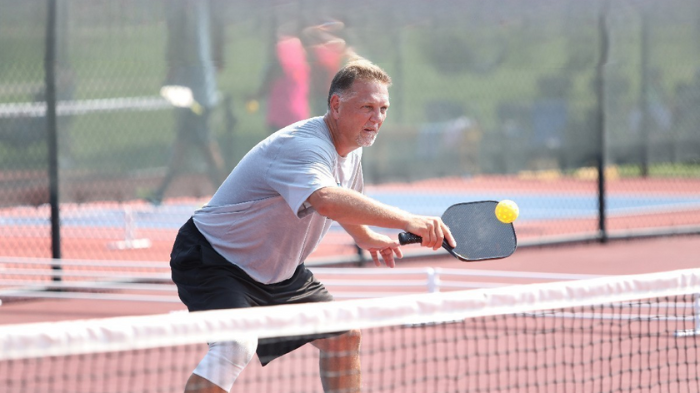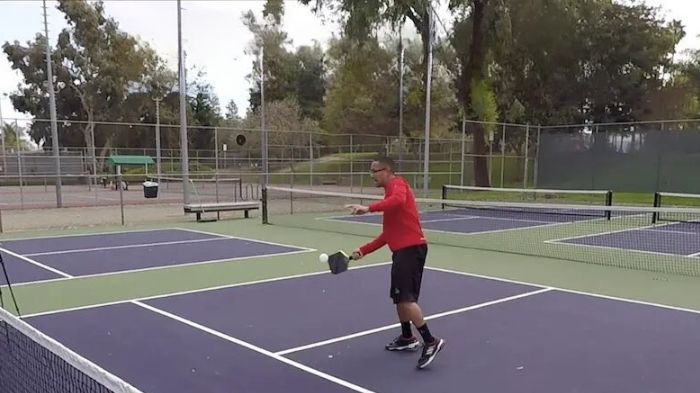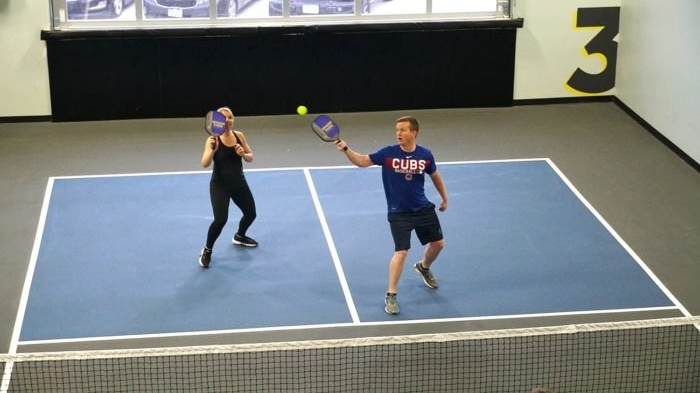Pickleball is an exciting and rapidly growing sport that combines elements of tennis, badminton, and table tennis. To excel in pickleball, it is crucial to understand and master the various pickleball strokes and pickleball shots. In this blog post, we are going to explain what is a stroke and shot in pickleball and the importance of strokes and shots in the game of pickleball.
We are going to discuss in this blog different types of pickleball shots and strokes in detail. Additionally, we are also going to explain how you can use both strokes and shots for effectively playing the game. Read this blog post, know about different strokes and shots in pickleball, and utilize both pickleball strokes and shots together to play pickleball. Also know the difference between indoor and outdoor pickleball clothes to wear while mastering the stroke.

What Is a Stroke and Shot in Pickleball?
In pickleball, a stroke and a shot refer to different types of hitting techniques used to return the ball.
Stroke: A stroke in pickleball generally refers to a more controlled and precise hitting technique. It is typically used for softer shots that require accuracy and placement rather than power. Strokes are often employed for shots like dinks, drops, or gentle volleys. A stroke involves a smooth, controlled swing with a shorter backswing, and it allows the player to finesse the ball over the net with better control.
Shot: A shot in pickleball typically refers to a more aggressive and forceful hitting technique. This type of stroke is employed by players when they aim to hit the ball forcefully and swiftly, with the intention of putting their opponents in a defensive position or achieving a winning shot. Shots are commonly utilized for drives, smashes, or powerful volleys. When executing a shot, players often employ a longer backswing and generate more power through the swing to hit the ball with force.
Proficiency in both strokes and shots is essential for pickleball players, considering their significance and the need to adapt techniques according to the situation. Choosing between a stroke or a shot depends on several factors, such as the ball’s position, the desired outcome, and the player’s personal style and preferences. Also learn women’s pickleball clothes, and what do you wear to play pickleball? In order to hit a stroke and a shot in pickleball.
Importance of Strokes and Shots in Pickleball
Strokes and shots are essential in pickleball as they allow players to control the ball, direct it strategically, and outmaneuver their opponents. The correct execution of strokes and shots enables players to:
Achieve Control And Placement: Strokes and shots in pickleball allow players to accurately place the ball where they want it to go, taking advantage of their opponent’s weaknesses and keeping them on the defensive.
Generate Power And Speed: Although pickleball doesn’t prioritize power as much as some other racket sports, the ability to generate power and speed in shots remains valuable. This can be used to drive the ball past opponents or put them under pressure, leading to errors or weak returns.
Incorporate Spin And Variation: Adding spins, like topspin or slice, to shots in pickleball adds complexity, making it harder for opponents to predict and handle the ball. By incorporating variations in angles, speeds, and spins, players can keep their opponents guessing and disrupt their ability to establish a comfortable rhythm.
Support Offensive And Defensive Play: In pickleball, different strokes and shots have both offensive and defensive roles. Offensive shots, such as aggressive drives or powerful smashes, are used to create opportunities for winning shots or to force errors from opponents. Defensive shots, such as soft dinks or well-placed lobs, are employed to counter the opponent’s aggressive play and provide time for players to reposition themselves on the court.
Enable Effective Shot Selection And Strategy: Choosing the right shot for a given situation is crucial. Shot selection depends on court positioning, the opponent’s position, shot quality, and game situation. It allows players to adapt, exploit weaknesses, and maintain control over the game.
Facilitate Transition And Net Play: Strokes and shots in pickleball are vital for success in net play. Volleys, blocks, and put-aways are frequently used close to the net. By seamlessly moving from the baseline to the net and executing shots skillfully, players can gain control of points, force opponents into a defensive position, and secure victories with winning shots.
Different Types of Strokes and Shots in Pickleball
Pickleball is a popular racquet sport that combines elements of tennis, badminton, and table tennis. It is played on a smaller court with a solid paddle and a perforated plastic ball. To excel in pickleball, it is essential to understand and master various strokes and shots. Here are the different types of strokes and shots in pickleball:
- Serve: The serve is the shot that starts the rally. The server must stand behind the baseline and diagonally across from the receiver. The most common serve in pickleball is an underhand serve, where the ball must be struck below the waist. The serve is typically hit diagonally cross-court to the opponent’s service box.
- Return Of Serve: The return of serve is the shot the receiver uses to send the ball back over the net after the serve. The objective is to keep the ball in play and gain an advantageous position for the next shot. The return of serve can be hit with various strokes, including forehand and backhand groundstrokes or volleys.
- Groundstroke: A groundstroke is a shot that is hit after the ball bounces once on the ground. In pickleball, groundstrokes are typically hit with an open stance, with the player’s body facing the net. There are two main types of groundstrokes in pickleball:
- Forehand Groundstroke: The forehand groundstroke involves gripping the paddle with the dominant hand at the bottom. To execute the shot, the player swings the paddle forward and makes contact with the ball on the side of their body corresponding to their forehand. This stroke is employed when hitting balls on the player’s forehand side.
- Backhand Groundstroke: The backhand groundstroke involves holding the paddle grip with the non-dominant hand at the bottom. Similar to the forehand groundstroke, the backhand groundstroke requires the player to swing the paddle. However, in this instance, the player makes contact with the ball on the opposite side of their body, known as the backhand side. This shot is employed specifically when hitting balls on the player’s backhand side.

- Volley: A volley refers to a shot executed in the air before the ball bounces on the ground. Being proficient in volleying is crucial in pickleball because it allows players to maintain control of the point and apply pressure on their opponents. There are two main types of volleys:
- Forehand Volley: To execute the forehand volley, the player places their dominant hand at the bottom of the paddle grip. The player moves closer to the net and hits the ball before it bounces, using a controlled swing motion on the forehand side of the body.
- Backhand Volley: The backhand volley is performed by positioning the non-dominant hand at the bottom of the paddle grip. The player approaches the net and strikes the ball before it touches the ground, employing a controlled swinging motion on the backhand side of their body.
- Dink Shot: The dink shot is a soft and controlled shot that is hit close to the net. It is typically used in the non-volley zone (also known as the kitchen) to keep the ball low and force the opponent into a difficult position. Executing the dink shot requires precision and finesse, as its objective is to keep the ball within the opponent’s reach while creating a challenging situation for them to launch a successful attack.
- Lob: A lob is a high, arching shot that is hit deep into the opponent’s court. The lob is used to create distance between the players and buy time to regain a favorable position. Lobs are particularly effective when the opponents are positioned close to the net or when they are expecting an aggressive shot.
- Drop Shot: The drop shot is a shot that is hit softly and lands just over the net. It is used to surprise the opponent and force them to move quickly towards the net. The drop shot requires finesse and control to make it difficult for the opponent to reach and return the ball.
- Smash: The smash is a powerful overhead shot that is hit with force and speed. It is executed when the ball is high in the air, allowing the player to generate a significant downward angle on the shot. It is a powerful attacking shot that aims to force the opponent into a defensive position and ultimately win the point.

How to Utilize Both Shots and Strokes Together for Playing Pickleball?
To effectively combine shots and strokes in pickleball, here are some tips:
Understand Shot Selection: Familiarize yourself with different shots like forehand groundstrokes, backhand groundstrokes, volleys, and dink shots. Recognize the situations where each shot is most suitable.
Maintain Court Positioning: Position yourself strategically based on the shot you anticipate. For groundstrokes, position yourself slightly behind the baseline, while for volleys, move closer to the net.
Utilize Proper Footwork: Footwork is crucial for quickly transitioning between shots. Practice moving your feet to position yourself correctly for each shot, ensuring balance and stability.
Blend Consistency And Aggression: Aim for consistency with your groundstrokes by focusing on controlled shots that keep the ball in play. When an opportunity arises, switch to more aggressive shots like volleys or overhead smashes to put pressure on your opponents.
Mix-Up Shot Placement: Vary the direction and placement of your shots to keep your opponents guessing and off balance. Alternate between shots to the forehand and backhand sides, as well as change the depth and angle of your shots.
Communicate With Your Partner: In doubles play, effective communication with your partner is essential. Coordinate your shots, anticipate each other’s movements, and make quick decisions on who will take specific shots.
Adapt To The Game Flow: Read the game and adjust your shots accordingly. If your opponent consistently struggles with volleys, incorporate more drop shots or lobs to exploit their weaknesses.
Practice Shot Transitions: Work on smoothly transitioning between different shots during drills and practice sessions. This will help you develop the ability to switch between groundstrokes, volleys, and dinks seamlessly.
FAQs
A pickleball stroke involves utilizing a wide array of techniques and executing precise movements to achieve effective contact with the ball.
Groundstrokes are shots that players use when the ball bounces before they hit it. They are typically executed from the baseline and involve hitting the ball after it has bounced once.
Yes, there are several advanced shots in pickleball, such as the lob, overhead smash, and around-the-post shots. These shots require more skill and practice to execute effectively.
Improving shot selection comes with experience and understanding of the game. Consider factors like court positioning, opponent’s positioning, shot angles, and your own strengths to make smarter shot choices.
To enhance your pickleball strokes, prioritize elements such as maintaining a proper grip, improving footwork, attaining optimal body positioning, and refining timing. Engage in practice drills, seek coaching guidance, and actively participate in matches with experienced players to further develop your skills.
Conclusion
Developing proficiency in the diverse range of pickleball strokes and shots is important for achieving success in the game. By understanding the different types of pickleball shots and strokes, their importance, and how to utilize them effectively, you can elevate your pickleball skills and enjoy a more competitive and enjoyable gameplay experience. Embrace the pickleball court, wholeheartedly commit to purposeful practice, and unleash your wide array of strokes and shots to assert your dominance and excel in the game!



